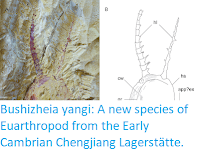The Middle Cambrian Guanshan Biota of Yunnan Province, China, preserves a wide range of soft-bodied fossils with fidelity similar to that seen in the slightly younger Burgess Shale. These fossils were originally discovered during construction work, and the sites which yielded the first known Guanshan Biota fossils have subsequently been lost, but recognition of the importance of these fossils led to a search for new localities, with several subsequently being discovered in Yiliang, Malong, Wuding, and Huize counties, as well as sites within the city prefecture of Kunming. Among these fossils are rare non-Trilobite Artiopods (the group which includes the Trilobites as well as a variety of less well known Palaeozoic Arthropod clades, most of which did not survive beyond the Cambrian), although the last specimen was described in 2008.
In a paper published in the Geological Magazine on 15 December 2021, De-Guang Jiao and Kun-Sheng Du of the Research Center of Paleobiology at Yuxi Normal University, Xi-Guang Zhang and Jie Yang of the Key Laboratory for Palaeobiology and Ministry for Education and China International Joint Laboratory for Palaeoenvironment at Yunnan University, and Daniel Eggink also of the Research Center of Paleobiology at Yuxi Normal University, describe a new species of non-Trilobite Artiopod from an outcrop producing Guanshan Biota fossils in Yiliang County in Yunnan Province, China.
The new species is named Bailongia longicaudata, where 'Bailongia' refers to the village of Bailong, which is close to the site where the specimen from which the species is described was found, and 'longicaudata' means 'long-tail'. The specimen is 5 mm in length, including the antennae and tailspine and 2.1 mm wide. It has a wide cephalon (head-segment), with eyes located close to the posterior corners, a tapering thorax with nine segments, and a long tailspine.
Bailongia longicaudata has all the key features of the Artiopoda (first antenniform limbs, exopod with lamellae, and homonomous dorsal exoskeleton with expanded tergopleurae), but none of the diagnostic features needed to place it within one of the currently recognised Artiopod sub-groups.
A phylogenetic analysis carried out by Jiao et al. using the TNT software package suggests that Bailongia longicaudata is part of a clade which also includes two of the main Artiopod divisions, the Trilobites and Vicissicaudates, to the exclusion of the third, the Protosuturans. In this reconstruction, the Trilobites and Vicissicaudates are sister groups, with Bailongia longicaudata being the sister to this combined group.
See also...



Online courses in Palaeontology.
Follow Sciency Thoughts on Facebook.
Follow Sciency Thoughts on Twitter.






